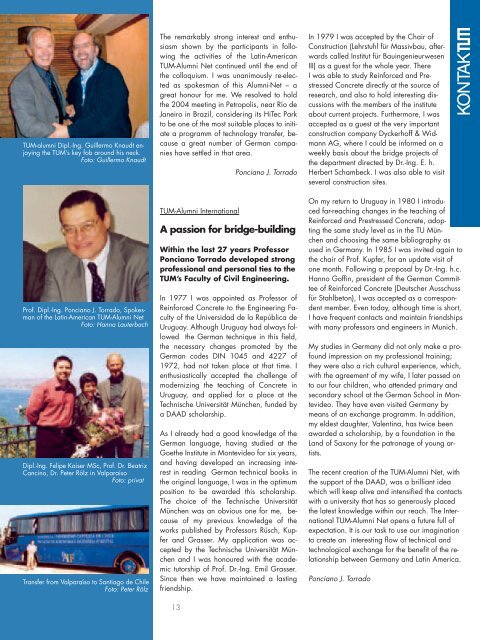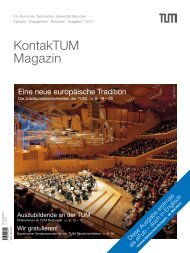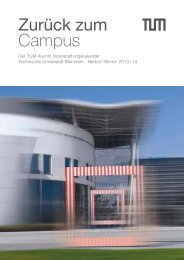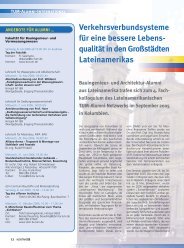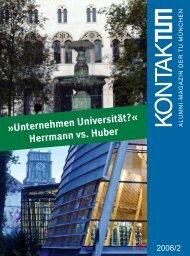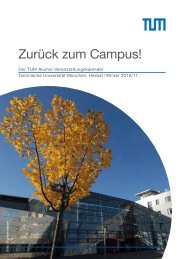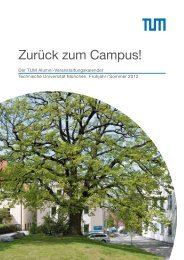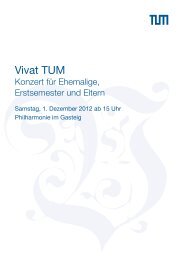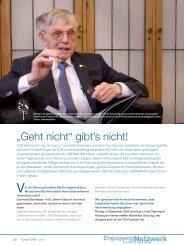Als PDF öffnen - Alumni - TUM
Als PDF öffnen - Alumni - TUM
Als PDF öffnen - Alumni - TUM
Erfolgreiche ePaper selbst erstellen
Machen Sie aus Ihren PDF Publikationen ein blätterbares Flipbook mit unserer einzigartigen Google optimierten e-Paper Software.
<strong>TUM</strong>-alumni Dipl.-Ing. Guillermo Knaudt enjoying<br />
the <strong>TUM</strong>’s key fob around his neck.<br />
Foto: Guillermo Knaudt<br />
Prof. Dipl.-Ing. Ponciano J. Torrado, Spokesman<br />
of the Latin-American <strong>TUM</strong>-<strong>Alumni</strong> Net<br />
Foto: Hanna Lauterbach<br />
Dipl.-Ing. Felipe Kaiser MSc, Prof. Dr. Beatriz<br />
Cancino, Dr. Peter Rölz in Valparaíso<br />
Foto: privat<br />
Transfer from Valparaíso to Santiago de Chile<br />
Foto: Peter Rölz<br />
The remarkably strong interest and enthusiasm<br />
shown by the participants in following<br />
the activities of the Latin-American<br />
<strong>TUM</strong>-<strong>Alumni</strong> Net continued until the end of<br />
the colloquium. I was unanimously re-elected<br />
as spokesman of this <strong>Alumni</strong>-Net – a<br />
great honour for me. We resolved to hold<br />
the 2004 meeting in Petropolis, near Río de<br />
Janeiro in Brazil, considering its HiTec Park<br />
to be one of the most suitable places to initiate<br />
a programm of technology transfer, because<br />
a great number of German companies<br />
have settled in that area.<br />
<strong>TUM</strong>-<strong>Alumni</strong> International<br />
A passion for bridge-building<br />
Within the last 27 years Professor<br />
Ponciano Torrado developed strong<br />
professional and personal ties to the<br />
<strong>TUM</strong>’s Faculty of Civil Engineering.<br />
In 1977 I was appointed as Professor of<br />
Reinforced Concrete to the Engineering Faculty<br />
of the Universidad de la República de<br />
Uruguay. Although Uruguay had always followed<br />
the German technique in this field,<br />
the necessary changes promoted by the<br />
German codes DIN 1045 and 4227 of<br />
1972, had not taken place at that time. I<br />
enthusiastically accepted the challenge of<br />
modernizing the teaching of Concrete in<br />
Uruguay, and applied for a place at the<br />
Technische Universität München, funded by<br />
a DAAD scholarship.<br />
As I already had a good knowledge of the<br />
German language, having studied at the<br />
Goethe Institute in Montevideo for six years,<br />
and having developed an increasing interest<br />
in reading German technical books in<br />
the original language, I was in the optimum<br />
position to be awarded this scholarship.<br />
The choice of the Technische Universität<br />
München was an obvious one for me, because<br />
of my previous knowledge of the<br />
works published by Professors Rüsch, Kupfer<br />
and Grasser. My application was accepted<br />
by the Technische Universität München<br />
and I was honoured with the academic<br />
tutorship of Prof. Dr.-Ing. Emil Grasser.<br />
Since then we have maintained a lasting<br />
friendship.<br />
13<br />
Ponciano J. Torrado<br />
In 1979 I was accepted by the Chair of<br />
Construction (Lehrstuhl für Massivbau, afterwards<br />
called Institut für Bauingenieurwesen<br />
III) as a guest for the whole year. There<br />
I was able to study Reinforced and Prestressed<br />
Concrete directly at the source of<br />
research, and also to hold interesting discussions<br />
with the members of the institute<br />
about current projects. Furthermore, I was<br />
accepted as a guest at the very important<br />
construction company Dyckerhoff & Widmann<br />
AG, where I could be informed on a<br />
weekly basis about the bridge projects of<br />
the department directed by Dr.-Ing. E. h.<br />
Herbert Schambeck. I was also able to visit<br />
several construction sites.<br />
On my return to Uruguay in 1980 I introduced<br />
far-reaching changes in the teaching of<br />
Reinforced and Prestressed Concrete, adopting<br />
the same study level as in the TU München<br />
and choosing the same bibliography as<br />
used in Germany. In 1985 I was invited again to<br />
the chair of Prof. Kupfer, for an update visit of<br />
one month. Following a proposal by Dr.-Ing. h.c.<br />
Hanno Goffin, president of the German Committee<br />
of Reinforced Concrete (Deutscher Ausschuss<br />
für Stahlbeton), I was accepted as a correspondent<br />
member. Even today, although time is short,<br />
I have frequent contacts and maintain friendships<br />
with many professors and engineers in Munich.<br />
My studies in Germany did not only make a profound<br />
impression on my professional training;<br />
they were also a rich cultural experience, which,<br />
with the agreement of my wife, I later passed on<br />
to our four children, who attended primary and<br />
secondary school at the German School in Montevideo.<br />
They have even visited Germany by<br />
means of an exchange programm. In addition,<br />
my eldest daughter, Valentina, has twice been<br />
awarded a scholarship, by a foundation in the<br />
Land of Saxony for the patronage of young artists.<br />
The recent creation of the <strong>TUM</strong>-<strong>Alumni</strong> Net, with<br />
the support of the DAAD, was a brilliant idea<br />
which will keep alive and intensified the contacts<br />
with a university that has so generously placed<br />
the latest knowledge within our reach. The International<br />
<strong>TUM</strong>-<strong>Alumni</strong> Net opens a future full of<br />
expectation. It is our task to use our imagination<br />
to create an interesting flow of technical and<br />
technological exchange for the benefit of the relationship<br />
between Germany and Latin America.<br />
Ponciano J. Torrado


